The NAD M23 Stereo Power Amplifier ($4,799 – Buy at Crutchfield) is a solid, handsome stereo power amplifier built around Purifi’s highly-regarded 1ET400A amplifier modules, combined with NAD’s custom power supply, input stages, and elegant full-width Masters Series casework. As part of NAD’s Masters Series (their most advanced product line), the M23 is a natural compliment to NAD’s M66 streaming DAC-preamp (read my review), M33 integrated amplifier and other Masters Series components. It also would be a fine companion to virtually any audiophile preamp, regardless of manufacturer.
A refreshed M23 Version 2 – featuring Purifi’s second-generation modules – arrives in late 2025, and we’ll review that, too. Based on NAD’s announcements so far, the two models will deliver the same key strengths, including power output, ability to be bridged into a high-power monoblock, and outstanding specs.
I recently adopted NAD’s M66 as my reference preamp and have been enjoying its sound and features. Given that, I was curious to hear how the M23 would sound alongside it. I got my chance when Lenbrook, NAD’s parent company, sent an M23 for review. Let’s take a close look at the features, specs, and sonic performance of the M23 to see what makes this Class-D amplifier worthy of NAD’s Master Series designation. It should be a great trip …
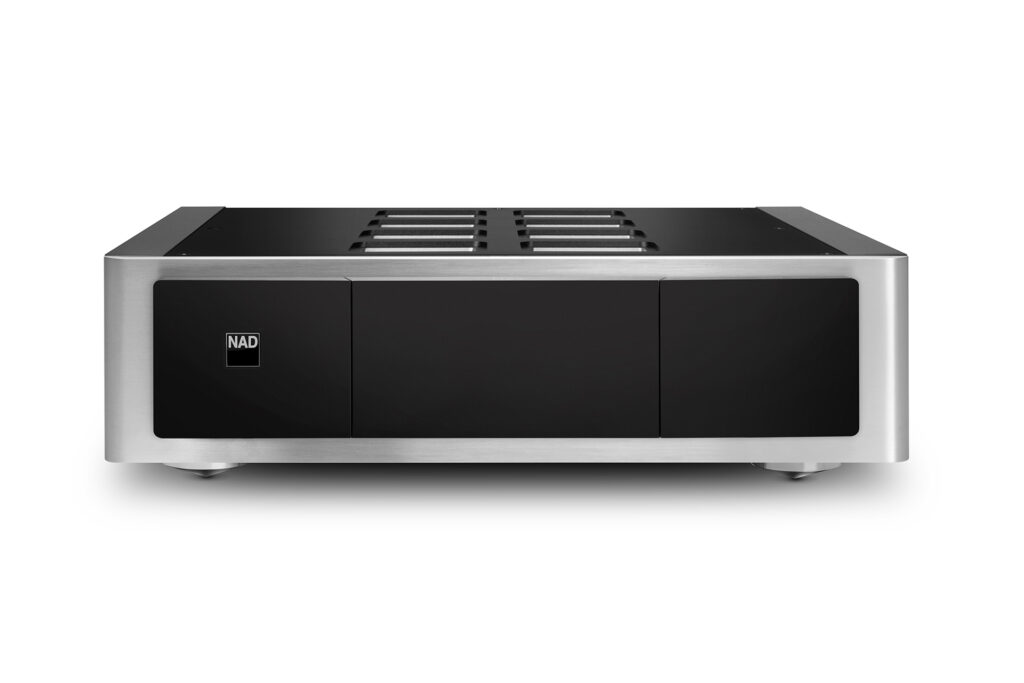
What Makes the NAD M23 Stereo Power Amp So Special?
- The 1ET400A amplification modules powering the NAD M23 are manufactured by NAD under license from Denmark’s Purifi Audio. Purifi’s modules have set new standards for audio amplifiers, and the licensing agreement gives NAD increased control over the M23’s production.
- Today’s best Class-D amplifiers, including the M23, compete head-to-head with excellent Class-A and Class-AB amps. While the best of anything is never cheap, at a given price point, the best Class-D amps give more power, more fidelity, and better load independence (meaning less trouble with loudspeaker matching), while using far less energy and throwing off far less heat. Class-D amps are lighter: most audiophiles will be able to move the M23, at 21.4 pounds, without needing help.
- The objective specs of the NAD M23 power amplifier are state-of-the-art. The amp’s high signal-to-noise ratio (127 dB) and low distortion (less than 0.005 percent, 20 Hz to 20 kHz, at 200 watts into eight ohms) rank up there with the best audiophile amps.
- The NAD M23’s wide, flat frequency response (± 0.06 dB, 20 Hz to 20 kHz) and vanishingly small output impedance mean that you will hear the sound of your source and your speakers, uncolored by amplifier-speaker interactions. Contrast this with amps with higher output impedances (typically, tube amps), which have frequency responses that interact with the speakers’ impedance characteristics.
- The NAD M23 is a powerful amp that can drive almost any audiophile speaker with ease, with more than 200 continuous watts per channel into an eight-ohm load (more than 380 watts into four ohms). Dynamic (short-term) power specs are 260 or 520 watts into the same loads.
- The audiophile wanting even more power can flip a switch and run the M23 in bridged mode, with mono output exceeding 700 continuous watts into eight ohms. Two would then be required for stereo or, if you have a NAD M33 integrated amplifier, you can pair one M23 in bridged mode with the M33 to get the same high output.
- The NAD M23 has both balanced (XLR) and single-ended (RCA) inputs. No matter what outputs your preamp or DAC has, you won’t need adapter cables, which simplifies an audiophile’s life.
- The NAD M23’s selectable gain ensures compatibility with just about any audio system. Several preamps I’ve auditioned lately have less gain than I’m used to, and the M23’s higher gain settings would be useful with them, especially playing conservatively recorded classical music, such as some recordings on the BIS label. When using a preamp with higher gain, the M23 can be switched to its low-gain setting to optimize the signal-to-noise ratio.
Why Should You Care About the NAD M23 Stereo Power Amplifier?
The potential owner of a NAD M23 is the audiophile shopping around this price point who wants outstanding objective and subjective performance with a touch of luxury, too. Here, luxury is provided by the M23’s many features and elegant casework. For example, the easily accessible power switch is a pleasure to have; the variety of gain settings, input connectors, and the well-spaced rear panel are handy; and the M23’s bespoke appearance and sturdy construction encourage pride of ownership – as well as resale value. For those shopping in this category, the M23 is a treat to see, as well as to hear.
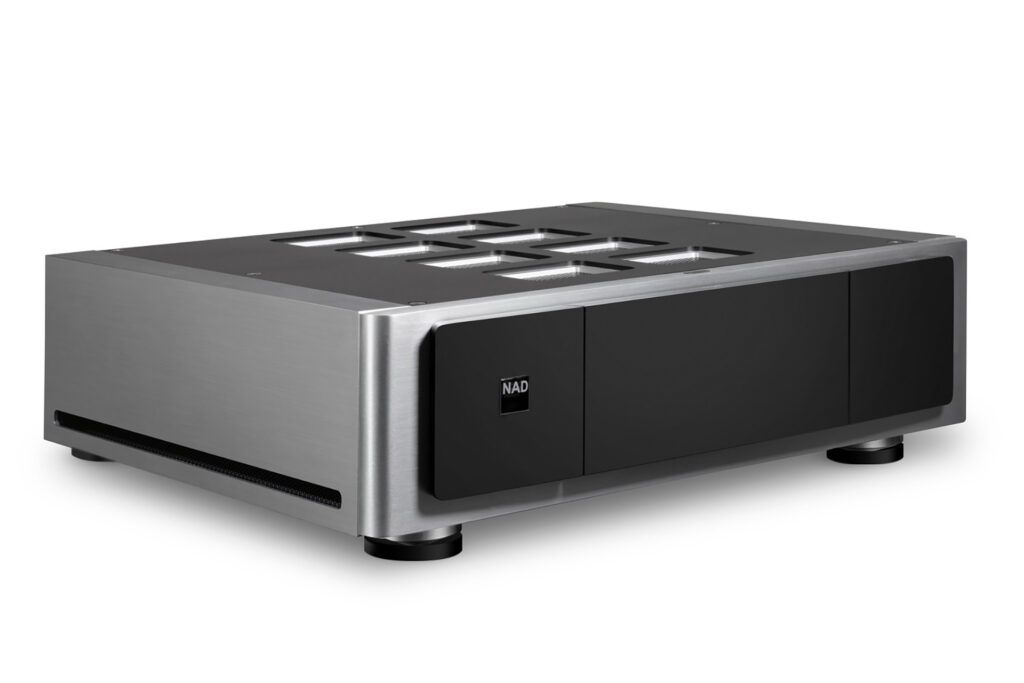
Some Things You Might Not Like About the NAD Masters Series M23 Stereo Power Amplifier
- The on/standby switch on the front top panel is a bit quirky. This touch switch has three functions, depending on length of touch. To turn on or put the amp into standby mode, touch the button. To enable or disable Auto Standby mode (amp enters standby after 30 minutes of no signal), hold the switch for more than 15 seconds. To enable or disable Auto Sense mode (amp wakes up when an audio signal is detected), hold the switch for between 10 and 15 seconds. Confusingly, my review sample wouldn’t enter standby until I turned off Auto Sense mode, but then the touch switch worked as expected. I’m not sure if the non-responsiveness in Auto Sense mode is a feature or a bug, but I found it odd. I turned off both Auto modes in order to control the M23 as I would any other power amp: switch it on when needed, switch it into standby when not needed. I would hope for better documentation and smoother operation in products positioned in a manufacturer’s flagship line.
- The (U.S.) warranty on the M23 is three years. Though that’s on par with many other products in its class, I would like to see longer warranties at this price point, maybe five to 20 years. If nothing else, a longer warranty would give the buyer added peace of mind. I can’t ding NAD too hard for offering a run-of-the-mill warranty, but I’d love to see more audio companies offer longer warranties on their premium products.
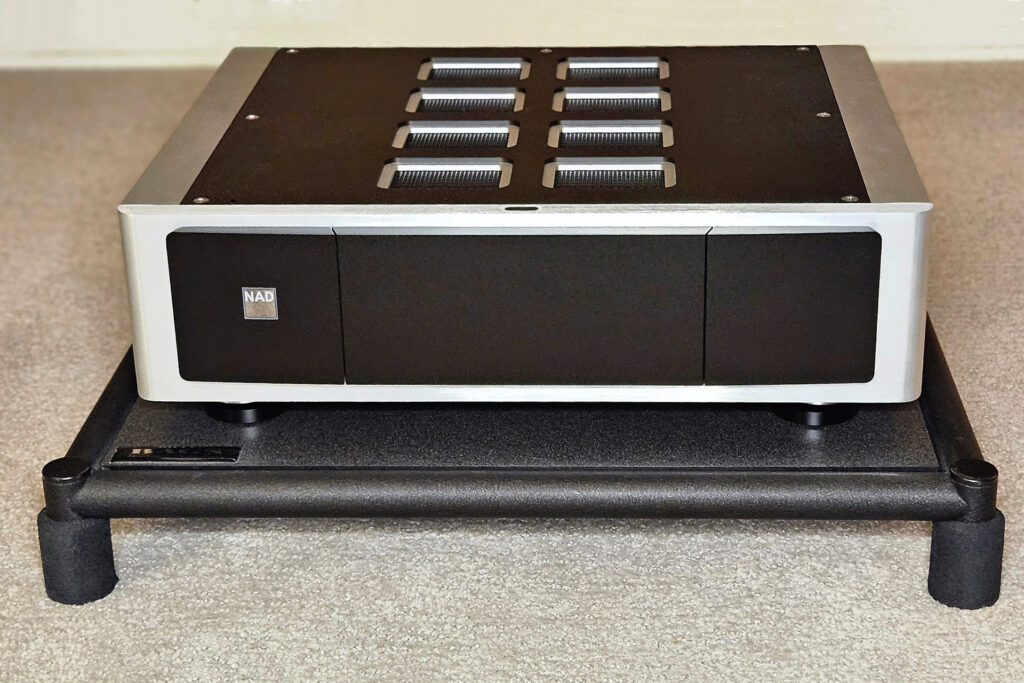
Listening to the NAD Masters Series M23 Stereo Power Amplifier …
For listening sessions, the NAD M23 was fed by my reference source, the NAD M66 streaming DAC preamp (read my review). I used the M66 to play both Qobuz streams and local files via Roon. I occasionally substituted a Topping DX9 DAC preamp, fed by a Raspberry Pi streamer, and came to similar conclusions about the M23. Speakers were my Janszen Valentina hybrid electrostatic floorstanding speakers (read my review) with aluminum cone woofers. My four subwoofers were off, to let the M23 operate full-range.
First up was Bob Marley’s classic “No Woman, No Cry” in the live concert version on Legend: The Best of Bob Marley and the Wailers (16/44.1, local file). Though this track was recorded some 50 years ago (July 15, 1975), it’s still a blast. Listening through the NAD M23, Marley’s voice sounded natural and human, his heartfelt delivery striking a chord. Imaging was realistic, and the soundstage, including the audience, was wall-to-wall, even in my rather dead room. Electric guitar at about 4:10 was suitably assertive, without the high-frequency distortion that can cause stridency. Percussion also was exceptionally clean. I imagine that the Dynamic Digital Headroom feature in the preamp helps in this, and the clean sound from the speakers also shows that high-frequency distortion in the M23 has been kept to very low levels. I’ve never heard this music sound better – though I did miss my subwoofers, hardly a fault of the M23.
Next, I put on the Tokyo String Quartet, playing Beethoven’s string quartet Opus 18/2 on a Harmonia Mundi recording (local rip at 16/44.1). I enjoy string quartets, but even if I didn’t, I’d find them useful in reviewing, because they are difficult to reproduce cleanly: the layering of bowed stringed instruments with high dynamic range, sharp transients, and wide harmonic spectra is a challenge for any playback system. It’s also a challenge for recording engineers, and this release (though its microphones are a bit too close for me) meets that challenge better than most.
The third movement of this quartet is a musical romp that plays the instruments off against one another. Throughout, the NAD M23 was clear, clean, and enjoyable, without strain or congestion. Tonality, whether of violin, viola, or cello, was excellent. I found it possible to follow the lines of the various instruments easily, though as expected, when all were playing together, the sound was impossible to pick apart. I experienced no treble irritation, and the imaging was clear as expected, with a natural but not overly reverberant acoustic contributing to the atmosphere. To summarize: the NAD M23 aced my string quartet test, with great tonality and clean treble.
My final selection was the audiophile favorite “I Put a Spell on You,” sung by Chantal Chamberland on her 2019 album Temptation (24/96 Qobuz). It’s hard to write about the sound, because I was captured by the music. The smoky quality of Chamberland’s voice came through with a natural quality, and her uncanny ability to infuse a down-tempo song with movement and drama also came through in spades. Imaging in this studio recording was stable and precise, never vague, and the reverb added atmosphere. Dynamic shadings large and small were excellent. All in all, playback through the NAD M23 demonstrated why this release is an audiophile demo track. There was plenty of power and dynamics, but no strain, no glare, no coloration, and excellent transparency. Truly, the M23 acted like a straight wire with gain.
Will the NAD M23 Stereo Power Amplifier Hold Its Value?
NAD Masters Series Components, with fine sound and attractive casework, are well-positioned to hold value for years. At the time I write this, though, a couple of issues cloud the matter. First, the M23 is about to be replaced by the M23 V2, which will affect resale value of the earlier model. Second, the M23 is fabricated in China, so the price for U.S. buyers is affected by tariffs, and tariff changes can affect value retention over time. Despite that, I expect that there always will be a good market for used NAD Masters Series components, given NAD’s large dealer network and longstanding fine reputation.
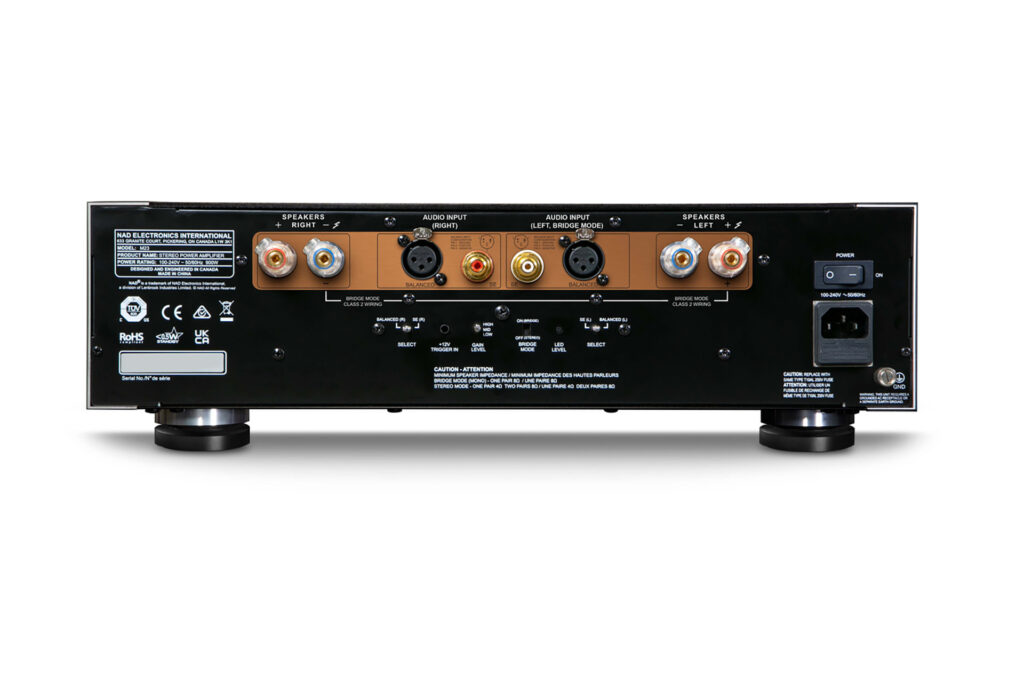
What is the Competition for the NAD Masters Series M23 Stereo Power Amplifier?
As usual, I urge audiophiles to audition before buying. When spending thousands of dollars on a power amp, a buyer should ask for a home trial with the right to return the product if the sound at home is not what you had hoped. More than once, I’ve happily paid full retail when a dealer did this.
The most direct competitor for the NAD M23 is the NAD Masters Series M23 V2 (pre-order at Crutchfield), announced at U.S. MSRP $4,999, with availability expected in the fourth quarter of 2025. The amps will be nearly identical visually, and I expect differences in sound to be subtle.
Orchard Audio’s Mono Ultra Premium amps ($5,199.90 per pair) are powerhouses, offering 250 watts continuous into eight ohms (500 watts into four ohms). They have excellent objective performance and open, transparent sound. Tradeoffs are Orchard’s less elaborate metalwork; the amps’ relatively low gain (19 dB), which may limit playback volume with some preamps; and the lack of single-ended inputs (although Orchard sells an active RCA-to-XLR converter). A pair of these amps is my current reference.
Also using Orchard Audio’s “Ultra” modules, the ArgentPur DUO stereo amplifier ($5,300) has silver internal wiring and gorgeous aluminum metalwork. Our review of the DUO is in process; in the meantime, you can read Jerry Del Colliano’s review of ArgentPur’s Monobloc amps, which are mono equivalents of the DUO.
The Atma-Sphere Class-D monoblocks ($6,350 per pair, read my review) are products of a longtime designer of tube electronics, who replaced the tube amps in his home system with his Class-D amps and is on record as not missing the tubes. These compact, solid, and attractive monoblocks feature 100 watts continuous into eight ohms (200 watts into four ohms), custom linear power supplies, balanced and single-ended inputs, and Atma-Sphere’s own Class-D modules.
Finally, if you would like to consider an amp offering outstanding objective performance but devoid of luxury or extra features, Buckeye Amps offers amplifiers based on the second-generation Purifi 1ET6525SA module, as I understand will be used in the NAD M23 V2. Housed in neat aluminum cabinets, Buckeye’s amplifiers use a proprietary input buffer, featuring balanced inputs and switchable gain. Prices are $875 per monoblock or $1,150 per stereo amp. We have reviewed several of Buckeye’s amps and found them to give great musical satisfaction.
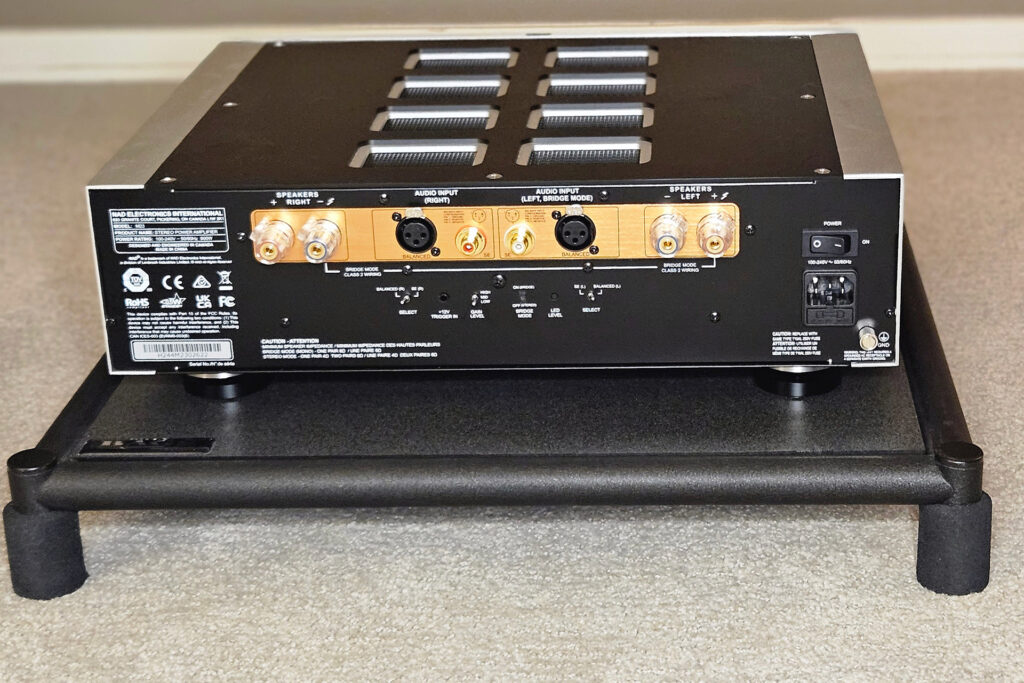
Final Thoughts on the NAD Masters Series M23 Stereo Power Amplifier …
Like other amps I’ve heard using Purifi’s amplifier modules, the NAD Masters Series M23 Stereo Power Amplifier is a fine-sounding component. Do NAD’s own input stages and power supply contribute to the smooth, involving sound? They certainly don’t hurt.
The NAD M23 also is a substantial piece of equipment, with full-sized casework and useful features like easy bridged operation and balanced as well as single-ended input connections. If you’re looking for a powerful amplifier with excellent sonics that also offers good looks and pride of ownership, the M23 easily should fit that bill. During the review period, I enjoyed it daily, I got lost in a music of varied genres, I stayed up way too late listening, and not for a moment did I think the setup needed sonic improvement. This is another fine piece of electronics from NAD.




As Orchard is your reference and you used them in the competition section some comments on comparison would have been nice.
I’d say that sonic differences between these two amps are subtle, and choosing between them will depend on the rest of one’s system as well as priorities and tastes, perhaps as much in non-sonic as in sonic matters. The Orchard amps have an open character that I enjoy; the NAD is steady and well controlled in a very good way. When I went back and forth, I never heard a striking difference, no matter what music was playing. Both amps are accurate and musical, and I could be delighted with either in my main system.